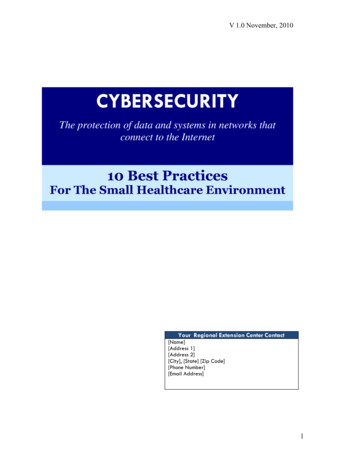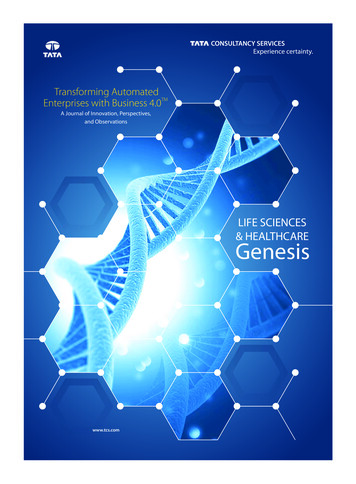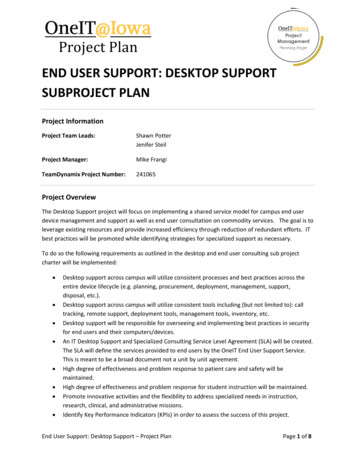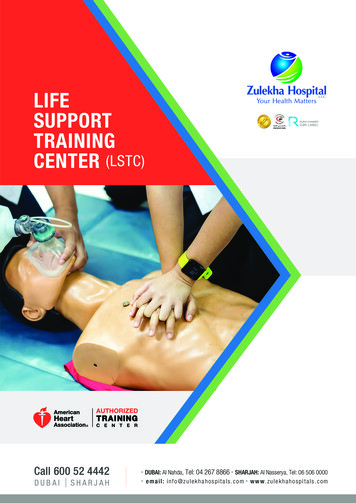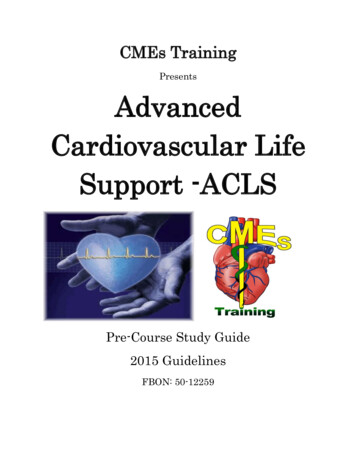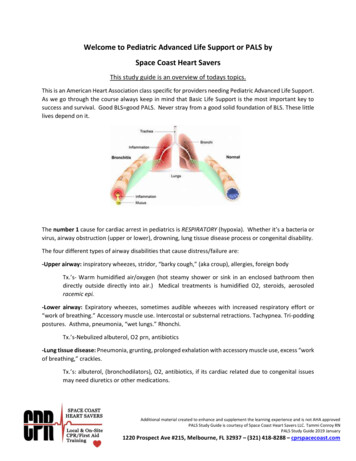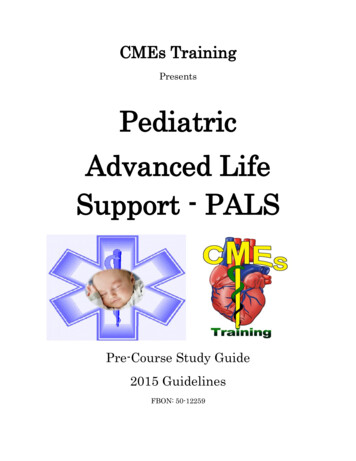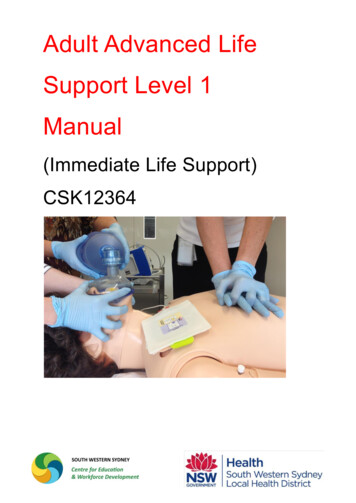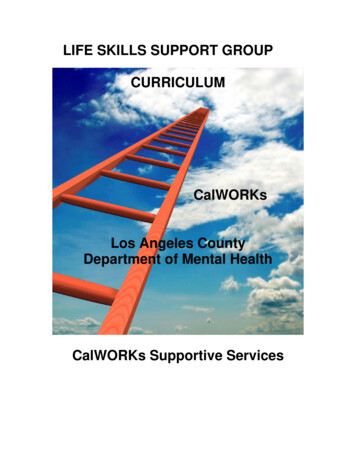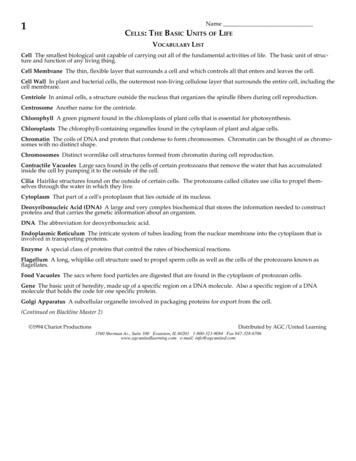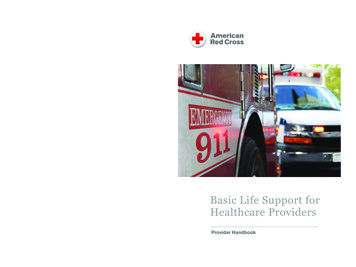
Transcription
Basic Life Support forHealthcare ProvidersCare steps outlined within this handbook are consistent with: 2010 International Liaison Committee on Resuscitation (ILCOR)Consensus on Science and Treatment Recommendations (CoSTR) 2010 American Heart Association Guidelines for CPR & ECCMembers of the American Red Cross Scientific Advisory Councilprovided guidance and review.The American Red Cross Scientific Advisory Council is a panel of nationallyrecognized experts drawn from a wide variety of scientific, medical and academicdisciplines. The Council provides authoritative guidance on first aid, CPR, emergencytreatments, rescue practices, emergency preparedness, aquatics, disaster health,nursing, education and training.For more information on the Scientific Advisory Council, ic-advisory-councilAbout the American Red Cross:The American Red Cross shelters, feeds and provides emotional support to victims ofdisasters; supplies about 40 percent of the nation’s blood; teaches skills that savelives; provides international humanitarian aid; and supports military members andtheir families. The American Red Cross is a not-for-profit organization that depends onvolunteers and the generosity of the American public to perform its mission. For moreinformation, please visit redcross.org or follow us on Twitter @RedCross.Basic Life Support forHealthcare ProvidersProvider HandbookStock No. 652180BLS-Handbook-Cover.indd 12/4/15 8:41 AM
American Red CrossBasic Life Supportfor Healthcare ProvidersHandbook53800 Basic Life HB FM pi-x.indd 12/4/15 10:07 AM
The Basic Life Support for Healthcare Providers Handbook is part of the American Red Cross BasicLife Support for Healthcare Providers program. The emergency care procedures outlined in the programmaterials reflect the standard of knowledge and accepted emergency practices in the United States atthe time this manual was published. It is the reader’s responsibility to stay informed of changesin emergency care procedures.PLEASE READ THE FOLLOWING TERMS AND CONDITIONS (the “Terms and Conditions”)BEFORE AGREEING TO ACCESS, USE OR DOWNLOAD THE FOLLOWING AMERICANNATIONAL RED CROSS MATERIALS. BY PURCHASING, DOWNLOADING, OR OTHERWISEUSING OR ACCESSING THE MATERIALS, YOU ACKNOWLEDGE AND HEREBY AGREE TO BELEGALLY BOUND BY BOTH THESE TERMS AND CONDITIONS AND THE AMERICAN NATIONALRED CROSS TERMS OF USE (AVAILABLE AT http://www.redcross.org/terms-of-use). YOUAGREE THAT THE INCLUDED COURSE MATERIALS ARE PROVIDED “AS IS” AND WITHOUTWARRANTIES OF ANY KIND, AND THAT ANY ACCESS TO OR USE OF THESE COURSEMATERIALS IS AT YOUR OWN RISK.The following materials (including downloadable electronic materials, as applicable) including all content,graphics, images and logos, are copyrighted by, and the exclusive property of, The American NationalRed Cross (“Red Cross”). Unless otherwise indicated in writing by the Red Cross, the Red Cross grantsyou (“Recipient”) the limited right to download, print, photocopy and use the electronic materials onlyfor use in conjunction with teaching or preparing to teach a Red Cross course by individuals or entitiesexpressly authorized by the Red Cross, subject to the following restrictions: The Recipient is prohibited from creating new electronic versions of the materials. The Recipient is prohibited from revising, altering, adapting or modifying the materials, which includesremoving, altering or covering any copyright notices, Red Cross marks, logos, or other proprietarynotices placed or embedded in the materials. The Recipient is prohibited from creating any derivative works incorporating, in part or in whole, thecontent of the materials. The Recipient is prohibited from downloading the materials, or any part of the materials, and puttingthem on Recipient’s own website or any other third-party website without advance written permissionof the Red Cross. The Recipient is prohibited from removing these Terms and Conditions in otherwise-permitted copies,and is likewise prohibited from making any additional representations or warranties relating to thematerials.Any rights not expressly granted herein are reserved by the Red Cross. The Red Cross does not permitits materials to be reproduced or published without advance written permission from the Red Cross. Torequest permission to reproduce or publish Red Cross materials, please submit your written request to TheAmerican National Red Cross.Copyright 2011, 2015 The American National Red Cross. ALL RIGHTS RESERVED.The Red Cross emblem, American Red Cross and the American Red Cross logo are trademarks of TheAmerican National Red Cross and protected by various national statutes.Published by StayWellPrinted in the United States of AmericaISBN: 978-1-58480-643-153800 Basic Life HB FM pi-x.indd 22/4/15 10:07 AM
The care steps outlined within this handbook are consistent with the 2010 International LiaisonCommittee on Resuscitation (ILCOR) Consensus on Science and Treatment Recommendations(CoSTR) and the 2010 American Heart Association Guidelines for CPR & ECC.ACKnowledgmentsThis handbook is dedicated to the thousands of employees and volunteers of the American RedCross who contribute their time and talent to supporting and teaching lifesaving skills worldwide andto the thousands of course participants who have decided to be prepared to take action when anemergency strikes.Content DirectionJonathan L. Epstein, MEMS, NREMT-PSenior Director, Science and Content DevelopmentAmerican Red CrossAmerican Red Cross Scientific Advisory CouncilGuidance and Review of the Basic Life Support for Healthcare Providers program was provided bymembers of the American Red Cross Scientific Advisory Council.The American Red Cross Scientific Advisory Council is a panel of nationally recognized expertsdrawn from a wide variety of scientific, medical and academic disciplines. The Council providesauthoritative guidance on first aid, CPR, emergency treatments, rescue practices, emergencypreparedness, aquatics, disaster health, nursing, education and training.For more information on the Scientific Advisory Council, visit visory-councilMembers of the Scientific Advisory Council at the time of publication include:LeadershipDavid Markenson, MD, MBA, FCCM,FAAP, FACEP, EMT-PChairChief Medical Officer, Sky Ridge MedicalCenterLinda Quan, MDVice ChairPediatric Emergency Physician, SeattleChildren’s HospitalProfessor of Pediatrics, University ofWashington School of MedicineResuscitation Sub-CouncilRichard N. Bradley, MDResuscitation Sub-Council ChairAssociate Professor of Emergency Medicine,University of Texas Medical School atHoustonDivision Chief of Emergency Medical Servicesand Disaster Medicine, University of TexasMedical School at HoustonMichael G. Millin, MD, MPH, FACEPResuscitation Sub-Council Vice ChairAssistant Professor of Emergency Medicine,Johns Hopkins University School of MedicineMedical Director, BWI Airport Fire and RescueDepartmentWendell E. Jones, MD, MBA, CPE, FACPChief Medical Officer, Veterans IntegratedService Network 17Assistant Professor, Internal Medicine,University of Texas SouthwesternSiobán Kennedy, MA, ACP, CQIAManager of Paramedic Practice, SunnybrookCentre for Prehospital MedicineBasic Life Support for Healthcare Providers Handbook53800 Basic Life HB FM pi-x.indd 3iii2/4/15 10:07 AM
Stamatios Lerakis, MD, PhD, FAHA,FACC, FASE, FASNC, FCCPProfessor of Medicine (Cardiology), Radiologyand Imaging Sciences, Emory UniversitySchool of MedicineDirector of Cardiac MRI and InterventionalEchocardiography, Emory University HospitalAdjunct Professor of Biomedical Engineering,Emory University and Georgia Institute ofTechnologyIra Nemeth, MDAssistant Professor in the Department ofMedicine, Baylor College of MedicineDirector of EMS and Disaster Medicine, BaylorCollege of MedicineAssistant Medical Director, Ben Taub GeneralHospital’s Emergency DepartmentJoseph W. Rossano, MDAssistant Professor of Pediatrics/Cardiology,University of Pennsylvania and Children’sHospital of PhiladelphiaJoan Elizabeth Shook, MD, FAAP, FACEPProfessor of Pediatrics, Baylor Collegeof Medicine Pediatric Emergency MedicineSectionNursing and Caregiving Sub-CouncilJean Johnson, PhD, RN, FAANNursing and Caregiving Sub-CouncilChairDean and Professor, George WashingtonUniversity School of NursingivSusan M. Heidrich, PhD, RNNurse Scientist, Middleton Memorial VeteransAdministration Hospital (Madison, WI)Helen Denne Shulte Emeritus Professor,University of Wisconsin –Madison School ofNursingJohn P. Hirdes, MDProfessor and Ontario Home Care Researchand Knowledge Exchange Chair, Universityof Waterloo School of Public Health andHealth SystemsSenior Canadian Fellow and Board Member,interRAIDeanna Colburn Hostler, DPT, CCS (ABD)Clinical Assistant Professor of PhysicalTherapy, University at Buffalo, StateUniversity of New YorkCarla M. Tozer, MSN, APN/CPN, ACHPH,ANP-BC, GNP-BCVisiting Nursing Practice Specialist/VisitingClinical Instructor, University of Illinois atChicago College of NursingTener Goodwin Veenema, PhD, MPH, MS,FNAP, FAANAssociate Professor and Pediatric EmergencyNurse Practitioner, Johns Hopkins Schoolof NursingPresident, CEO of Tener Consulting Group,LLCChristy Blackstone, MSW, LCSWLicensed Clinical Social Worker and CaregiverSupport Coordinator, Alexandria VeteransAffairs Health Care SystemFirst Aid Sub-CouncilAndrew MacPherson, MD, CCFP-EMFirst Aid Sub-Council ChairEmergency Physician, Victoria, BCMedical Consultant, British ColumbiaEmergency Health ServicesBarbara J. Burgel, RN, ANP, PhD, FAANProfessor of Clinical Nursing and Adult NursePractitioner, University of California, SanFrancisco, School of Nursing Occupational andEnvironmental Health Nursing Graduate ProgramL. Kristian Arnold, MD, MPH, FACEPChief Medical Officer, ArLac HealthServicesMedical Director, Boston Police DepartmentOccupational Medicine UnitSusan L. Carlson, MSN, APRN, ACNS-BC,GNP-BC, FNGNANurse Practitioner, South Texas VeteransHealthcare System Neurology DepartmentDavid C. Berry, PhD, ATC, EMT-BAssistant Professor and Coordinator of AthleticTraining Clinical Education, Weber StateUniversityMarie O. Etienne, DNP, ARNP, PLNCProfessor and Faculty Service-LearningCoordinator, Miami Dade College Schoolof NursingAdelita Gonzales Cantu, PhD, RNAssistant Professor, University of Texas HealthScience Center Department of Family andCommunity Health SystemsAmerican Red Cross53800 Basic Life HB FM pi-x.indd 42/4/15 10:07 AM
Sarita A. Chung, MDDirector of Disaster Preparedness, BostonChildren’s Hospital Division of EmergencyMedicineJeffrey H. Fox, PhDRegional Chair of Disaster Mental Services,American Red Cross Northeast New YorkRegionRobin M. Ikeda, MD, MPH, USPHSDeputy Director for Noncommunicable Diseases,Injury and Environmental Health, Centers forDisease Control and Prevention (CDC)Lewis J. Kaplan, MD, FACS, FCCM, FCCPAssociate Professor, University of PennsylvaniaPerelman School of Medicine Division ofTraumatology, Surgical Critical CareDirector of the SICU, Philadelphia VA MedicalCenterDeborah C. Mandell, VMD, ACVECCAdjunct Associate Professor, Emergency andCritical Care Medicine, Veterinary Hospitalof the University of PennsylvaniaNational American Red Cross Pet Care AdvisorEdward McManus, MDInfection Disease Specialist, St. Claire’s HealthSystemJeffrey L. Pellegrino, PhD, WEMT-B/FF,EMS-IEMS-Instructor and EMT/Firefighter, City ofHudson (OH)Strategic Initiatives and Assessment ofUndergraduate Studies, Kent StateUniversityTod SchimelpfenigCurriculum Director, NOLS WildernessMedicine InstituteS. Robert Seitz, M.Ed, RN, NREMT-PAssistant Professor, University of Pittsburgh’sSchool of Health and RehabilitationSciences Emergency Medicine ProgramEunice (Nici) Singletary, MD FACEPAssociate Professor of Emergency Medicine,University of VirginiaJeffery S. Upperman, MDAssociate Professor of Surgery, Universityof Southern CaliforniaAttending Surgeon and Director of TraumaProgram, Children’s Hospital of Los AngelesAquatics Sub-CouncilPeter G. Wernicki, MD, FAAOSAquatics Sub-Council ChairAssociate Clinical Professor of OrthopedicSurgery, University of Florida MedicalSchoolMedical Advisor, U.S. Lifesaving AssociationChair, International Life Saving Federation’sMedical CommitteeAngela K. Beale, PhDAssistant Professor, Department of HealthStudies, Physical Education and HumanPerformance Science, Adelphi UniversityPeter R. Chambers, PhD, DOChair of Emergency Medicine, Mayo ClinicHealth System/LaCrosseMedical Director, Great Lakes Region of theUnited States Lifesaving AssociationRoy Fielding, MS, LGIT, WSITSenior Lecturer of Department of Kinesiology,University of North Carolina at CharlotteVice Chair, Centers for Disease Control andPreventions’ Model Aquatic Health CodeTechnical Committee on Bather Supervisionand LifeguardingVice Chair, Technical Committee onRecirculation and FilteringLouise KublickAquatics Operations Manager, HollandBloorview Kids Rehabilitation Hospital(Toronto, ON)Stephen J. Langendorfer, PhDProfessor of Exercise Science and InterimDirector, Bowling Green State UniversitySchool of Human Movement, Sport, andLeisure StudiesTeresa (Terri) Lees, MSAquatic Supervisor, North Kansas CityCommunity CenterAquatic Coordinator, Wichita State UniversityHeskett Center for Campus RecreationLinda Quan, MD, FAAPPediatric Emergency Physician, SeattleChildren’s HospitalProfessor of Pediatrics, University ofWashington School of MedicineBasic Life Support for Healthcare Providers Handbook53800 Basic Life HB FM pi-x.indd 5v2/4/15 10:07 AM
William Dominic Ramos, MS, PhDAssociate Professor, Indiana University Schoolof Public Health-BloomingtonSenior Associate Faculty Member, JohnsHopkins University Medical InstitutesDepartment of International HealthPreparedness and Disaster HealthSub-CouncilJames A. Judge, II, EMT-P, CEM, BPAPreparedness and Disaster HealthSub-Council ChairEmergency Management Director, VolusiaCounty (FL)Steven Jensen, PhDAdvisor and Lecturer in EmergencyManagement, California State University atLong BeachJudith K. Bass, PhD, MPHAssistant Professor, Johns Hopkins BloombergSchool of Public Health Department ofMental HealthFaculty Member, Johns Hopkins BloombergSchool of Public Health Center for Refugeeand Disaster Response (CRDR)Richard Bissell, PhD, MS, MAProfessor, University of Maryland, BaltimoreCounty Emergency Health ServicesGraduate Program Director, University ofMaryland, Baltimore County EmergencyHealth ServicesFrederick (Skip) M. Burkle, Jr., MD, MPH,DTM, FAAP, FACEPSenior Fellow and Scientist, Harvard Schoolof Public Health Harvard HumanitarianInitiativeSenior International Public Policy Scholar,Woodrow Wilson Center for InternationalScholarsThomas D. Kirsch, MD, MPH, FACEPDirector, Center for Refugee and DisasterResponseAssociate Professor, Johns Hopkins BloombergSchool of Public Health, School of Medicineand Whiting School of EngineeringJohn R. Lindsay, MCPAssistant Professor, Brandon UniversityApplied Disaster and Emergency StudiesDepartmentRebecca S. Noe, MN, MPH, FNPEpidemiologist, Centers for Disease Controland PreventionProject Officer, American Red Cross–CDCDisaster Mortality and Shelter MorbiditySurveillance SystemsScott C. Somers, PhD, EMT-PMember, Phoenix AZ Fire DepartmentHazardous Materials Specialist, FEMA UrbanSearch and RescueErika S. Voss, CBCP, MBCISenior Business Continuity Manager, MicrosoftInteractive Entertainment BusinessSpecial ThanksWe would like to extend our gratitude to the Fairfax County Fire & Rescue Department and theFairfax County Fire & Rescue Academy without whose support we could not have successfullypiloted and produced video for this program.Thank you to Fire Chief Richard Bowers, Assistant Chief Garrett Dyer and Deputy Chief ManuelBarrero for their willingness to accommodate the American Red Cross. A special thank you alsoto Captain II Willie F. Bailey and Battalion Chief Jerome Williams for coordinating volunteers andresources, and ensuring the highest level of participation in this program’s pilot and video production.Lastly, we owe a debt of gratitude to the many department firefighters, EMT’s and medics who gavetheir time and valuable insight.viAmerican Red Cross53800 Basic Life HB FM pi-x.indd 62/4/15 10:07 AM
Table of ContentsSECTION 1: BASIC LIFE SUPPORT 1Introduction 2Basic Life Support 3Arriving on Scene 4Scene Size-Up 5Using Your Senses 5Initial Impression 6Primary Assessment of the Unresponsive Adult Patient Level of Consciousness (LOC) 66Airway 7Simultaneous Breathing and Pulse Check 8Primary Assessment Results 8Providing CPR/AED for Adults 12Compressions 13Ventilations 13Mouth-to-Mouth Ventilations Basic Life Support for Healthcare Providers Handbook53800 Basic Life HB FM pi-x.indd 714vii2/4/15 10:07 AM
Pocket Mask Ventilations 14Bag-Valve-Mask Resuscitator 15Special Considerations: Advanced Airways 16Stopping CPR 16Automated External Defibrillators 17Using an AED 18AED Safety 19One-Rescuer and Two-Rescuer CPR—Adult 21One-Rescuer CPR 21Two-Rescuer CPR 21High-Performance CPR 22Chest Compression Fraction (CCF) 23Integration of More Advanced Personnel 23Crew Resource Management 24Providing CPR/AED for Children and Infants 25Pediatric Considerations 26Age 26Consent viii26American Red Cross53800 Basic Life HB FM pi-x.indd 82/4/15 10:07 AM
Additional Resources CPR/AED Differences Between Children and Adults Airway 272727Compressions 29Compressions-to-Ventilations Ratio 29AEDs 29CPR/AED Differences for Infants Primary Assessment Variations: Infant 3131Airway 31Compressions 32AEDs 33Providing Care for an Obstructed Airway 36Obstructed Airway 37Caring for an Adult and Child 37Caring for an Infant 38Section 2: Skill Sheets 39CPR/AED—Adult 40CPR/AED—Child 42Basic Life Support for Healthcare Providers Handbook53800 Basic Life HB FM pi-x.indd 9ix2/5/15 9:06 AM
CPR/AED—Infant 44Section 3: Additional Topics 47Key Skills 48Critical Thinking 48Problem Solving 48Communication 49Teamwork 50The Emergency Medical Services System 51Legal Considerations 51Standard Precautions 53Appendix 55Basic Life Support Differences: Adult, Child and Infant 55Index 57Photography CreditsPage 2: iStockphoto.com/kali9Page 5 (top): Image marcelozippo, 2015. Used under license from Shutterstock.comPage 5 (bottom): Image MegaPixel, 2015. Used under license from Shutterstock.comPage 10: Image Robert Kneschke, 2015. Used under license from Shutterstock.comPage 12: iStockphoto.com/mkurtbasPage 20: Image Jaimie Duplass, 2015. Used under license from Shutterstock.comPage 25: Image GelpiJM, 2015. Used under license from Shutterstock.com Image SamuelBorgesPhotography, 2015. Used under license from Shutterstock.com Image richyrichimages, 2015. Used under license from Shutterstock.com Image michaeljung, 2015. Used under license from Shutterstock.comxAmerican Red Cross53800 Basic Life HB FM pi-x.indd 102/5/15 10:13 AM
Section 1:Basic Life SupportBasic Life Support for Healthcare Providers Handbook53800 Basic Life HB SEC 1 p001-038.indd 112/4/15 11:26 AM
IntroductionWhen a patient experiences a respiratory arrest, cardiac arrest orobstructed airway, you need to act swiftly and promptly starting withbasic life support skills.2American Red Cross53800 Basic Life HB SEC 1 p001-038.indd 22/4/15 11:26 AM
Basic Life SupportBasic Life Support (BLS) refers to the care healthcare providers and publicsafety professionals provide to patients who are experiencing respiratory arrest,cardiac arrest or airway obstruction. BLS includes psychomotor skills for performinghigh-quality cardiopulmonary resuscitation (CPR), using an automated externaldefibrillator (AED) and relieving an obstructed airway for patients of all ages. BLS alsofocuses on the integration of the following key skills to help rescuers achieve optimalpatient outcomes: Critical thinking: clear and rational thinking based on facts presented and thelearner’s experience and
Francisco, School of Nursing Occupational and Environmental Health Nursing Graduate Program Susan L. Carlson, MSN, APRN, ACNS-BC, gNP-BC, FNgNA Nurse Practitioner, South Texas Veterans Healthcare System Neurology Department Marie O. Etienne, dNP, ARNP, PLNC Professor and Faculty Service-Learning Coordinator, Miami

